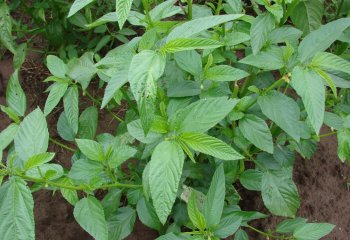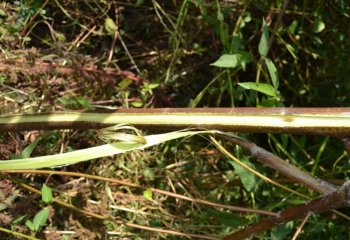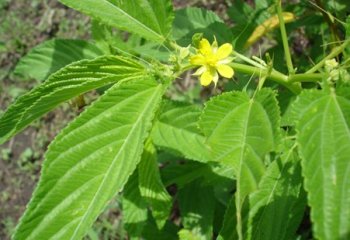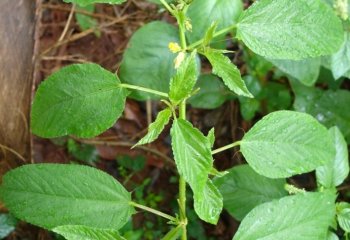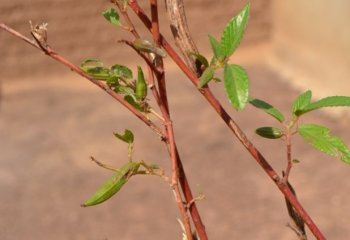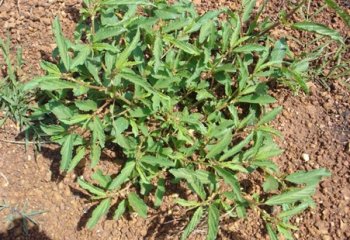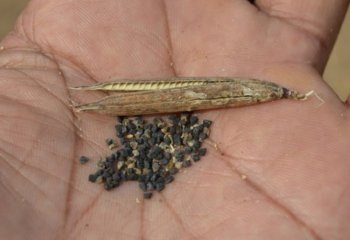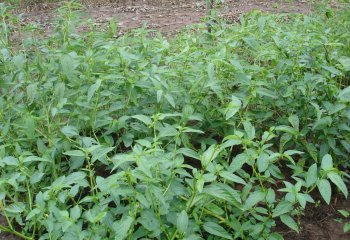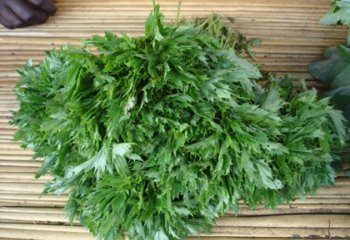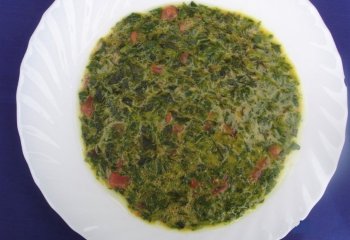Geographical Distribution in Africa
The origin of <i>Corchorus olitorius</i> has been a subject of debate due to its extensive cultivation in both Asia and Africa for centuries, as well as its natural occurrence in both continents. However, due to the existence of wild Corchorus species and greater genetic diversity within <i>C. olitorius</i> in Africa, it is believed to be the primary center of origin for the genus, with a secondary centre of diversity in the Indo-Burmese region. <i>C. olitorius</i> is native to the tropics of the Old World countries i.e. Africa and Asia. It is has been introduced into the New World countries (Americas and the Caribbean) including some isolated islands in the Indian and Pacific oceans. <i>C. olitorius</i> is now widely cultivated as a vegetable in many tropical African countries and is also found growing wild in the region (Fondio, L. & Grubben, G.J.H., 2011, Maundu et al., 1999).
Read more
Mauritania; Laalo Baal (Corchorus tridens L.)
Mozambique: Therere, Derere
Namibia: Okalyaoipute (Oshiwambo) (C. tridens)
Niger: Malohyia (Hausa) (C. tridens).
Nigeria: Ewedu (Yoruba), Lalo (Hausa); Kerenkere (Igbo), Rama, Ayoyo (Hausa), Ahuhara (Igbo); Malafiya (Hausa); Ebiyoyo (Bini)
Senegal: Laalo baali
South Africa; Wilder jute (Afrikaans); Thelele, Ligusha (Sepedi, Sesotho, Sestwana); Delele (Tshivenda); Guxe, Ligushe (Xitsonga, Shangaan)
Togo: Ademe
Uganda: Otigo winyo (Acholi), Liloth (Adhola), Othigu kal (Alur), Alilot, Atigo, Atigo na apolon (Ateso), Otigo-afuku (Alur)
Zimbwabwe: Derere-renyenje (Shona); Gusha (Shona); Gwisha (Shona); Idelele (Ndebele); Isileleda (Ndebele); Siachikwiye (Tonga); Telele-buyu (Tonga)
Local names (Detailed)
Angola: Anana, Nana (Umbundu) (C. tridens) (Bossard, E., 1996),
Benin: Ninnouwi (Fon), Ayoyo (Ifè), Ooyo (Tchabè), Yoyo (Idatcha), Nénouwi (Mahi), Adémain (Cotafon), Aluilui (Wémè), Ayoyo, Yoyo (Anii, Dendi, Ifè, Idatcha, Kotocoli, Démi (Adja), Èyo (Holly), Minapouwopouwona (Gourmantché), Ninnouwi (Fon, Mahi), Oyo (Tchabè), Yoyora, Sékéfèèma (Waama), Tifanhanti (Ditamari), Yôyôkoun (Bariba), Yôyôgoula (Boko) (C.olitorius); Azataluga, Glénonmandovodu (Fon), Itcho (Ifè), Djogodo (Idatcha), Alanlin(Mahi), Untcho, Itcho (Ifè), Éiyo (Holly), Èyo Aguidan (Holly), Bawounna Guimanhannain (Anii), Djaga (Tchabè), Fakou (Dendi), Fêêman (Waama), Gnainriké, Nonmonnon (Bariba), Ifanhanyéi (Ditamari), Lonlouin (Adja), Tignanlifaré (Gourmantché); Viwonla (Boko).(C. tridens) (Achigan et al., 2010).
Botswana: Ledelele, Chinyovana, Delele (Matlhare et al., 1999)
Burkina Faso: Wenwere poo (Dagara) (Maundu, 2014); Bulvag-Raaga (Corchorus tridens); Bulvagka (Corchorus olitorius L.) (Nadembega et al., 2011); Boulvanka (Corchorus olitorius) (Savadogo et al., 2016).
Cameroon: Tegue (Bulu, Ewondo); Gbarack (Bafia); Teuere messi (Bamoun); Django (Bassa); Lalo (Fufuldé, Haoussa); Nkelang (Bamilékés); Keleng keleng (Douala) (Kamga et al., 2014)
DRC: Mulembo (Kongo); Dongo Dongo (Lingala) (Latham & Mbuta, 2006)
Ethiopia: Lalka (Gumuz); Wodha lalka (Maundu, 2021); Rurague lagda (Afar) (C. tridens) (Le Floc'h, et al, 1985).
Kenya: Chikosho, Vombo (Chonyi); Mlenda, Mwatsaka Wa Bara, Bombo (Digo); Vombo, (Giriama); Chikosho, Vombo (Kambe); Omotere (Kisii); Murere (Luhya (Bukusu); Omurere (Luhya (Kabras )); Omurele (Luhya (Kisa)); Murere (Luhya (Marachi); Omurere (Luhya (Tiriki); Apoth, Apoth-Nyapololo (Luo); Chow (Pokot); Sanya: Kikosho (Sigor); Mlenda, Mulenda, Kala (Swahili); Ntereryan (Kibingor)(Tugen); Namale, Lojeel, Emarot, Abungu Turkana) (C olitorius)(Maundu et al., 1999); Luuftoole (Borana); Luftoole (Gabra); Murere-Nalubenga, Murere-Nalubembe, Sitanyamurwe, Nalubembe, Nalubonga (Luhya (Bukusu); Omurere (Luhya (Kabras); Mrere (Luhya (Maragoli); Omurere (Luhya (Tiriki); Lihu, Oluvembe Luhya (Tachoni); Apoth (Luo); Karkar, Kokorwo (Singular)( Marakwet); Qaqalla (Huri Hills); Chepkarkarian, Mamapatontoluo, Mamachemeloi (Pokot); Leperia Sanya: Kikosho (Samburu); Mlenda (Swahili) (C. trilocularis L) (Maundu et al., 1999)
Malawi: Chilenzi (C. Olitorius); Denje (C. Olitorius, C. trilocularis, C. tridens) (Maundu, 2021)
Mali: Laalo baali (C. tridens) (Ba, A. S, 1984)
Mauritania; Laalo Baal (Corchorus tridens L.) (Ba, A. S., 1984)
Mozambique: Therere, Derere (Maundu, 2021)
Namibia: Okalyaoipute (Oshiwambo) (C. tridens) (Hedimbi & Chinsembu, 2012).).
Niger: Malohyia (Hausa); Faku (Zarma); Fakuhô (Peuhl); Afakaw (Tamacheck); Gwanzeïna (Beriberi) (C. tridens) (Adjanohoun, É. J, 1980).
Nigeria: Ewedu (Yoruba), Lalo (Hausa); (Aiyeloja & Bello, 2006); Kerenkere (Igbo), Rama, Ayoyo (Hausa), Ahuhara (Igbo); Malafiya (Hausa); Ebiyoyo (Bini): Ulogburu (Ibo). (Ezuruike & Prieto, 2014).
Senegal: Laalo (Ba, A. S, 1984).
South Africa: Wilder jute (Afrikaans); Thelele, Ligusha (Sepedi, Sesotho, Sestwana); Delele (Tshivenda); Guxe, Ligushe (Xitsonga, Shangaan) (WS Jansen van Rensburg et al., 2009)
Togo: Ademe (Holaly et al, 2015))
Uganda: Otigo winyo (Acholi); Liloth (Adhola); Othigu kal (Alur); Alilot, Atigo, Atigo na apolon (Ateso); Atiriko lobi, Mulakia (Lugbara); Kumulere (Lugisu); Omutere (Lugwe); Kamutyereri (Lugwere); Mutere (Lusoga); Opeiba, Angurunya (Madi); Elolot (Ngakarimojong); Eteke (Runyoro); Eteke (Rotoro): Otigo-afuku (Alur) (Anywar, et al, 2014)
Zimbwabwe: Derere-renyenje (Shona); Gusha (Shona); Gwisha (Shona); Idelele (Ndebele); Isileleda (Ndebele); Siachikwiye (Tonga); Telele-buyu (Tonga) (Hyde et al., 2021)
Introduction
Corchorus olitorius (Jute mallow) is a plant species classified under family Malvaceae and the genus Corchorus. This genus has about 40-100 species of flowering plants distributed in tropical and subtropical regions from Asia to Africa. In Africa, Corchorus is represented by over a dozen species, most of which may be used as leafy vegetables. The most important is Corchorus olitorius found nearly all over the continent. Other significant species include C. trilocularis, C. tridens and C. aestuans which are often tolerated in crops field. Corchorus olitorius has various uses, with its leaves and young stems being consumed as a leafy vegetable. The leaves can be eaten raw or cooked; used fresh in salads, cooked as a side vegetable, or made into soup. The cooked jute mallow leaves are mucilaginous, and dried leaves can be used as a thickener in soups or brewed as a tea. Due to its slimy nature, the vegetable is usually combined with other coarser vegetables like spider plant, slender leaf and cowpeas to enhance their palatability.
In West Africa, immature fruits of Jute Mallow are referred to as 'bush okra' and can be dried and ground into powder for use in soups during the dry season. In Zambia and other southern African countries, soda and salt are added to the cooking process to further enhance the slippery consistency of the final relish. The bark and root of Jute Mallow have medicinal properties, with root scrapings used to treat toothache and a root decoction as a tonic. An infusion from the leaves is taken against constipation, and are used as a purgative and febrifuge. Corchorus is also used as a laxative.
Jute mallow also has industrial uses, with fibre obtained from the stem of jute mallow varieties developed for that purpose used to make rope and jute bags. Jute has been the most widely used packaging fibre for more than 100 years because of its strength and durability, low production costs, ease of manufacturing, and availability in large and uniform quantities.
(Maundu et al., 2009, Fondio, L. & Grubben, G.J.H., 2011).
|
|
|
Species account
Corchorus olitorius is a tall, erect, woody herb that typically grows to a height of 0.5 to 1.2 meters, although it may reach 2.5 meters in cultivation. It has a strongly branched structure with elongate leaves that have serrated margins. The plant produces yellow flowers and grey-black seeds, and its fruit is a short-stalked, cylindrical capsule that splits into 5 parts. The seeds are greyish black and angled. The plant species exhibits a notable level of diversity, comprising numerous distinct varieties that are cultivated for their unique characteristics. These characteristics include variations in leaf size, shape, and colour, as well as variations in the quality and quantity of fibre produced. The Sudan type has an extremely irregular leaf margin with protrusions. The species' diverse range of properties can be attributed to its extensive cultivation and adaptation to various environmental conditions (Maundu et al., 1999, AVRDC 2016).
|
|
|
|
Related species
1. Corchorus trilocularis is a typically erect, branched herb with ovate or broad leaves that have serrated margins. The plant produces yellow flowers and slender, long pod-like capsules, which are usually straight or slightly curved and split into 3-4 valves. C. trilocularis is widespread throughout tropical Africa and can also be found in tropical and subtropical regions of Asia and Australia. In Africa, it occurs from Mauritania and Cape Verde in the west to South Africa in the south, and from Somalia, Comoros, Madagascar, and Mauritius in the east, with many recorded sightings in between. It is a common species in most parts of Kenya, found in open Acacia bushland, grassland, cultivated areas, flood plains, edges of marshy places, and near dams and lakes. It can grow at elevations of up to 2,400 meters and is adapted to a range of soil types, including sandy alluvial, black cotton, sandy, or clay soils. C. trilocularis is used for a variety of purposes in different parts of the world. In Africa, it is often consumed as a leafy vegetable or used as a source of fibre for making ropes, baskets, and mats. In some areas, the plant is also used for medicinal purposes, including the treatment of malaria, stomach pains, and diarrhoea. (Maundu et al., 1999, Schippers, R.R., 2004).
2. Corchorus tridens is a herbaceous annual erect or spreading herb that grows to a height of 1 m, but usually much shorter. The stem is reddish with alternate leaves that are narrowly ovate to lanceolate or elliptical in shape, sparsely pubescent, and usually pale green. The fruit is a slender cylindrical capsule up to 4 cm long and 2 mm wide that dehisces by three valves and has three small spreading horns at the apex. Corchorus tridens is common in tropical Africa, as well as Nepal, Pakistan, India, and Northern Australia. It is used as a vegetable, both gathered from the wild and grown in home gardens, and has some importance in Benin, Cameroon, Kenya, Mozambique, Niger, Nigeria, and South Africa. (Mnzava, N.A., 2004, Achigan et al., 2010, Ken fern., 2021).
|
Ⓒ Maundu, 2005 |
|
3. Corchorus aestuans: commonly known as ""West African Jute" is an annual herb that grows up to a height of 1-2 meters. The species can be distinguished by several unique characteristics. The plant's leaves have serrated margins arranged alternately. At the base, the leaves have three veins, which distinguish them from other species. The plant produces small clusters of yellow flowers, typically 1-3 in number that are positioned opposite the leaves.
The plant species is widely distributed in tropical Africa, from Senegal to Ethiopia and Tanzania, and is commonly found in open woodlands, savannas, and disturbed habitats such as roadsides and fields. In East Africa, it grows in areas with an annual rainfall of 600-1000 mm
In West Africa, the leaves and stems are used as a vegetable to a lesser extent compared to Corchorus olitorius. This plant has various uses in traditional African medicine, where the leaves are used to treat dysentery, fever, and headaches. The roots and stem bark are used as a laxative and for the treatment of gonorrhoea and urethral discharges. Furthermore, its fibre is utilized to make ropes, twines, and mats. The plant also serves as a source of green manure, which improves soil fertility. (N’danikou & Achigan, 2011)
4. Corchorus pseudo-olitorius is a spreading herbaceous annual plant that grows to a height of about 1 m, but usually much shorter. Leaves are long and narrow to nearly oval and may be up to 10 cm longand 3 cm wide and often with a pair of basal protrusions (setae). Flowers are borne in threes or less. The fruit is a slender cylindrical capsule up to 4 cm long and 2 mm wide that dehisces by three valves and has three small spreading horns at the apex. Corchorus pseudo-olitorius is found along the coast of East Africa from Tanzania through Kenya to Somalia and also in India and Pakistan. In these areas it may be found in seasonally wet areas and also during the rainy season usually at an elevation of under 600 m. It is used as a vegetable, both gathered from the wild and grown in home gardens.
Ecological information
Corchorus prefers warm humid weather and does not tolerate cold weather. The optimum temperature is about 25°C to 32°C. Jute mallow performs best in areas with an annual rainfall of 600 – 2000 mm per year. Jute mallow prefers well-drained rich loam soils though it can grow in a wide range of soils. The optimum pH is 4.5 to 8.2. It does not do well under shade.
Agronomic aspects
Land preparation
Land is tilled to a fine tilth because of the small size of seeds. This also creates the friable texture needed by fragile roots of the young plants. The soil should have adequate organic matter, which not only adds nutrients to the soil but also improves its structure, thereby increasing its water holding capacity. The soil and the manure need to be mixed thoroughly.
Ⓒ Maundu, 2005
Planting
Jute mallow is easily propagated from seeds. Farmers can harvest their own seeds from a few plants kept for that purpose in their farms until fruit maturity. To avoid dormancy, seeds should not be sown within four months of harvesting. If seed dormancy is an issue, heat treatment can be employed as a solution. To do this, place the seeds in a cloth bag and immerse it in simmering water for 5-10 seconds. Then, subject the bag to a second "shock" by placing it in cold water for 5-15 minutes. Afterward, dry the seeds in the shade for up to one day. This method can effectively break dormancy and improve seed germination. Treated seeds need to be sown immediately for the most uniform seedlings germination. Seeds should be mixed with sand or soil in a 1:10 ratio for even distribution at sowing. Broadcasting is not recommended as it causes seed waste. For sowing in rows, a spacing of 50cm x drill is used. Seeds are sown directly and covered with a thin layer of soil.
Well-decomposed cattle manure is applied at the rate of about 3-4 kg/m² if broadcasting, or 1 kg/m² when sowing in rows. If using chicken manure, use ½ - ¼ of the amount of cattle manure. Four to five weeks after germination, seedlings about 15cm tall should be thinned until a spacing of 10cm from one plant to another is achieved. Some of the plants thinned can be transplanted, 3 weeks after sowing, into holes dug at 30cm x 20cm apart and 6 inches deep. A seed rate of 2.5kg/ha is used. Seeds should be sown just before the rains when the soil is warm. Jute mallow seed can be sown directly on prepared land either as a monocrop or intercropped with other crops.
(AVRDC & IPGRI., 2006, Fondio, L. & Grubben, G.J.H., 2011).
Cropping systems
Most farmers consider the combination of Corchorus with staple food crops as a profitable means of early revenue generation whilst waiting for other crops to mature. Corchorus is compatible for planting with many staple crops, but it has low competitive ability when combined with vegetables. It may be found together with many different species of vegetables in peri-urban gardens and combinations with staple crops are uncommon. Companion crops are selected without any consideration for disease and pest reactions and the crop’s nutrient demands. Farmers may plant tomato, Celosia and Corchorus together, all of which are highly susceptible to nematode attack.
Mixed cropping by means of alternate rows with different species could be beneficial for both crops. Some farmers grow one row of amaranth followed by a row of Corchorus. Such mixed cropping with amaranth will be useful to reduce the eelworm population normally encountered in a Corchorus crop. Jew’s mallow can be planted together with staple crops but it has a low competitive ability when combined with vegetables especially when crops like tomatoes are included which are similarly susceptible to nematode attack. Intercropping with maize or beans does not significantly reduce the vegetative yield of Corchorus.
© Maundu, 2010
Harvest, post-harvest practices and markets
a. Harvesting
The jute mallow plants grow quickly and are ready for the first cutting in about 60-70 days. The first harvest by cutting shoots 20-30 cm long may take place 4-6 weeks after transplanting at a height of 10-20 cm above the ground. This cutting stimulates the development of side shoots. Subsequently every 2-3 weeks a cutting may take place, in total 2-8 cuttings. For a once-over harvest from a direct sown crop the plants are uprooted or cut at ground level when they are 30-40 cm tall, 3-5 weeks after emergence, and before fruit development. The plants are bundled for marketing. In intercropping systems, farmers tend to harvest at irregular intervals. Wild Jew's mallow is picked from the vegetation when required, usually for home consumption. Different varieties have different growth habits. Cultivars with rapid early growth are suitable for harvesting by uprooting, while late-maturing cultivars may be more amenable to ratoon cropping. (AVDRC & IPGRi., 2006, Fondio, L. & Grubben, G.J.H., 2011)
b. Post-Harvest Management.
Post-harvest losses can be severe when the crop is handled poorly during harvest or after that. Shelf life of 1 or 2 days is possible when moist conditions together with low temperatures are maintained. If cooled to 20ºC, it can be kept for about one week in cold storage for several weeks. If the leaves are dried and pounded to powder, the product can be kept for half a year. Harvesting should be done late in the evening if the product is to be marketed the following day or very early in the morning if it is to be sold the same day. The vegetable is tied into bunches and placed on a wire mesh where it will not be stacked on top of each other and will have sufficient air circulation. Jute stems are retted in water for a period of (8- ) 15-20(-30) days to free the fibres from the bark. When retting is complete, the fibres are striped manually from the stems, subsequently washed and dried, and then graded and packed. The leaves may be dried and stored for later use. Preservation is done by sun-drying. The leaves may be dried and stored for up to one year. (AVRDC & IPGRI., 2006 Fondio, L. & Grubben, G.J.H., 2011).
Value addition and markets
Jew’s mallow is one of the leading leafy vegetables in many African countries and much cultivated and traded. No statistical data on production or marketing are available. International trade with neighbouring countries occurs, but is not registered. In Europe, Jew’s mallow is sold in powder form as a Lebanese product, under its Arab name ‘meloukhia’. The world jute production (combined data from Corchorus olitorius and Corchorus capsularis) has been stable over the past 40 years. In the period 1997-2001 it averaged 2.76 million tonnes of fibre per year. India and Bangladesh together produced more than 90% of the total (AVRDC & IPGRI., 2006).
Ⓒ Maundu, 2005
© Maundu, 2005
Nutritional value and recipes
Jute mallow is a highly nutritious vegetable, rich in several essential nutrients. It contains a significant amount of dietary fibre, which aids in digestion and helps maintain bowel regularity. It is also low in calories, making it a great choice for those looking to manage their weight.
Additionally, jute mallow contains minerals such as calcium, iron, magnesium, and potassium. Calcium is essential for strong bones and teeth, iron is necessary for oxygen transport in the body, magnesium is involved in various biochemical reactions, and potassium helps maintain proper heart function and fluid balance.
Jute mallow is an excellent source of vitamins and minerals. It is particularly rich in vitamin C, which is essential for a healthy immune system and collagen production. It also provides good amounts of vitamin A, which is important for eye health, and vitamin K, which plays a vital role in blood clotting and bone health. The leaves also contain six different antioxidants that help protect the body against damage caused by harmful free radicals. Antioxidants have been associated with a reduced risk of chronic diseases such as heart disease, cancer, and age-related macular degeneration. The leaves are also a rich source of folic acid. Folacin deficiency results in megaloblastic anaemia, which is prevalent among pregnant women in many developing countries (AVRDC & IPGRI., 2006).
Table 1: Approximate composition and level of nutrients in raw and cooked Jute mallow (Corchorus olitorius)
|
Jute mallow, picked leaves, raw |
Jute mallow, picked leaves, boiled, drained (without salt) |
Jute mallow, picked leaves, stewed (without salt) |
Recommended daily allowance (approx.) for adultsa |
Proximate composition and dietary energy |
|
|
|
|
Edible conversion factor |
0.48 |
1.00 |
1.00 |
|
Energy (kj) |
187 |
197 |
231 |
9623 |
Energy (kcal) |
45 |
47 |
56 |
2300 |
Water (g) |
82.3 |
81.4 |
78.2 |
2000-3000c |
Protein (g) |
4.6 |
4.9 |
5.7 |
50 |
Fat (g) |
(0.2) |
0.2 |
0.2 |
<30 (male), <20 (female)b |
Carbohydrates (g) |
2.1 |
2.2 |
2.6 |
225 -325g |
Fiber (g) |
8.3 |
8.7 |
10.2 |
30d |
Ash (g) |
2.5 |
2.6 |
3.1 |
|
Mineral composition |
|
|
|
|
Ca (mg) |
207 |
207 |
255 |
800 |
Fe (mg) |
6.3 |
5.0 |
7.8 |
14 |
Mg (mg) |
30 |
19 |
37 |
300 |
P (mg) |
88 |
84 |
109 |
800 |
K (mg) |
283 |
149 |
349 |
4,700f |
Na (mg) |
18 |
14 |
23 |
<2300e |
Zn (mg) |
0.58 |
0.46 |
0.72 |
15 |
Se (mg) |
1 |
1 |
1 |
60 |
Bioactive compound composition |
|
|
|
|
VIT A RAE (mcg) |
217 |
205 |
241 |
800 |
VIT A RE (mcg) |
434 |
411 |
482 |
800 |
Retinol (mcg) |
0 |
0 |
0 |
1000 |
Beta carotene (mcg) |
2603 |
2466 |
2892 |
600 – 1500g |
Thiamine (mg) |
0.09 |
0.06 |
0.10 |
1.4 |
Riboflavin (mg) |
0.34 |
0.23 |
0.40 |
1.6 |
Niacin (mg) |
0.53 |
0.4 |
0.6 |
18 |
Folate (mcg) |
117 |
61 |
101 |
400f |
VIT B12 (mcg) |
0 |
0 |
0 |
3 |
VIT C (mg) |
44.5 |
18.3 |
32.2 |
60 |
Source (Nutrient data): FAO/Government of Kenya. 2018. Kenya Food Composition Tables. Nairobi, 254 pp. http://www.fao.org/3/I9120EN/i9120en.pdf
$ Draining the water several times leaches away water soluble nutrients significantly.
a Lewis, J. 2019. Codex nutrient reference values. Rome. FAO and WHO
b NHS (refers to saturated fat)
c https://www.hsph.harvard.edu/nutritionsource/water/
d British Heart Foundation
e FDA
f NIH
g Mayo Clinic
Complimentary recipes
Jute mallow is an important leafy vegetable in many countries. The leaves and tender stems are eaten boiled, stew, stir-fried, or in soup. It is eaten with starchy foods like ugali. Sticky leaf mass is used as vegetarian spread. Leaf and tender stems are rich in vitamins A, C, E, B2, folic acid, calcium, iron and protein. Jute mallow is often mixed with cowpea leaves to soften the later especially when the leaves are mature.
© Maundu, 2005
a. Fried Mlenda (Mgunda)
Biodiversity recipe book for traditional leafy vegetables. Unpublished
Ingredients
• 100 g Jute mallow leaves
• 40 g onion
• 50 g tomatoes
• 3 tablespoonfuls cooking oil
• ½ cup coconut milk or fresh milk
• ½ cup groundnut flour
• 4 tablespoonfuls of lemon juice
• Salt to taste
Preparation
- Select the tender leaves wash and chop finely. Squeeze the lemon juice and sprinkle on it
- Wash, peel and chop the tomatoes
- Clean, wash and chop the onion
- Fry the onions lightly, add tomatoes and stir till soft
- Add chopped Jute mallow leaves and stir well, cover the pan for 5-10 minutes in order to boil. Simmer
- Add milk and stir for 5 minutes
- Season to taste and serve while hot as a relish
Remark
The vegetable has a slight lemon taste.
It is not slimy because of the addition of lemon juice
b. Jute Mallow with roasted groundnuts
Cameroon dish
Ingredients
• 1 bundle jute mallow leaves
• 2 cups (400 g) groundnuts
• 6 smoked fish
• 2 tomatoes
• 1 large onion, 1 clove garlic, two yellow peppers
• 1 spoonful refined vegetable oil
• Seasoning (salt, yellow pepper)
Preparation
- Wash and slice the jute mallow leaves finely.
- Roast groundnuts until crispy. Let cool, then remove the nuts and grind to a paste.
- Finely chop the onion.
- Clean the clove of garlic and crush with the tomatoes and peppers.
Cooking Procedure
- In a pan, heat some oil and brown the finely chopped onion.
- Add the sliced leaves.
- Simmer for ten minutes, then add the paste of garlic, pepper and tomatoes.
- Season with salt. Let cook a few minutes.
- Add fish and water, then cover.
- When the pot is boiling, add the groundnut paste, reduce the heat, and let cook uncovered, until the soup thickens.
- Remove the pot from the fire and season to taste.
- Serve with grated cocoyam or fufu.
Source; Traditional vegetables recipes from Cameroon. (Takemore chagomoka et al., 2014)
c. White soup with Jute Mallow
Cameroon dish
Ingredients
• 1 bundle jute mallow leaves
• 3 cups (600 g) groundnuts
• 6 smoked fish (sole preferred)
• 1 spoonful (125 ml) refined vegetable oil
• 1 large onion
• 2 large tomatoes
• 1 clove of garlic, 1 small piece of ginger, 1 leek, 1 stalk celery,
two yellow peppers
• 0.5 g limestone
• Seasoning (salt, pepper, stock cubes)
Preparation
- Wash and slice the jute mallow leaves finely.
- Soak the groundnuts for 30 minutes, then rinse and drain.
- Clean and crush together add leek, celery, ginger, garlic, tomatoes and peppers.
- Soak the smoked fish in hot water, remove the bones and clean the flesh.
- Dissolve limestone in water; filter to remove grit.
- Heat limestone water in a pan.
Cooking procedure
- Place a pan on the fire; add the oil and heat. Brown the chopped onion, then add the fish and simmer for a few minutes.
- Add the fresh groundnut paste diluted in one liter of water, cover and simmer for 20 minutes, stirring from time to time to prevent the paste from sticking to the bottom of the pot.
- Mix the sliced jute mallow leaves with a tablespoonful of boiling limestone liquid and stir;
- pour the mixture into the pan with the groundnuts and mix vigorously.
- Cover and simmer for ten minutes; adjust the seasoning and serve with grated cocoyam or fufu.
Source; Traditional vegetables recipes from Cameroon. (Takemore chagomoka et al., 2014)
d. Jute Mallow with pumpkin seeds
Cameroon dish
Ingredients
• 1 bunch jute mallow
• 1 kg meat
• 6 smoked fish (cod preferred)
• 2 cups (400 g) pumpkin seeds
• 2 tomatoes
• 1 clove garlic, 1 piece of ginger
• 1/4 litre refined vegetable oil
• 1 large onion
• Seasoning (salt, pepper, stock cubes)
Preparation
Wash and slice the leaves of jute mallow finely, boil in water with salt and drain. Crush together tomato, garlic and ginger.
Grind pumpkin seeds and mix with water.
Cooking procedure
- Cook the meat with water and salt.
- Heat a spoonful of vegetable oil and brown the finely chopped onion.
- Add the crushed tomato, garlic, and ginger.
- Add the cooked meat and crumbled fish. Simmer.
- Add the jute mallow and boil 15 minutes.
- Gradually add pumpkin seed powder.
- Cover the pot and cook for 20-30 minutes.
- Adjust the seasonings and remove from fire. Serve with fufu corn, fufu, yam, plantain or cassava stick
Source; Traditional vegetables recipes from Cameroon. (Takemore chagomoka et al., 2014)
Information on Pests.
The most serious pests are nematodes from the genus Meloidogyne, leaf-eating beetles and caterpillars. When it is dry, eight to ten weeks after planting, yield losses can occur due to leaf bugs and spider mites attacks resulting in terminal shoot wilt. Damage by nematodes can be minimized by crop rotation. Major pests affecting Jute mallow include red spider mites, flea beetles and nematodes. Infection of the latter can greatly reduce the yields and cause up to 100% plant loss (AVRDC & IPGRI., 2006).
i. Red spider mites
Damage description
Sack sap from leaves, causing reduced leaves and yields. A nuisance, especially during the dry season
What to do
• Application of water to pathways and other dusty areas at regular intervals is important to prevent spider mite attack. Water-stressed plants are less tolerant of spider mite damage.
• Use of natural enemies (Scolothrips sexmaculatus) or the larvae and adults of lady beetle (Dreistadt, et al, 2004)
ii. Flea beetles or other small black beetles
Damage description
They damage leaves by chewing them, thereby creating holes
What to do
• Wood ash can help control this pest.
iii. Aphids
Damage description
They attach the terminal buds and leaves retard in growth.
What to do
• -use of natural predators like the lady bug
• -Spray with neem oil
iv. Nematodes
Damage description
These can cause about 100% crop loss. The root knot nematodes usually cause root swellings which in turn distort the growth of the plant. They may also cause Chlorosis, reduction in the number and size of leaves and hence reduced yields
What to do
• Crop rotation
• Use fresh poultry manure
• Intercrop with Amaranthus but avoid other crops susceptible to root-rot nematodes for at least one year (AVRDC & IPGRI., 2006)
Information on Diseases
Diseases (bacterial and virus infections) are not as serious as pests. Damping off in seedlings occurs but can be reduced by good drainage and cultivation in humus-rich soils with adequate water holding capacity.
Contact information
1. Simlaw seeds. Jews Mallow -Mrenda packaged in 100 grams packets.. Contact: (+254)794-546-935. Email: customercare@simlaw.co.ke. Address: SIMLAW HOUSE, Kijabe St, Nairobi City. Web: https://simlaw.co.ke/product-details/1199/280
2. Simlaw (Uganda).
a. HEAD OFFICE, Plot 78-84 6th Street Industrial Area. P.O.Box. 21303 Kampala, Tel: +256 417 130 151. Email: simlaw@simlawseeds.com
b. MASINDI BRANCH: Masindi Port Road next to Masindi Stadium. Tel: +256 705 758 838
c. NAKIVUBO BRANCH: Plot 18-24 Nakivubo Road. G.B Plaza Container Village. Tel: +256 755 056 923
d. MBALE BRANCH: Plot 4 Central Road Former Foods and Beverages Building Mbale. Tel: +256 706 777 002
e. KAPCHORWA BRANCH: Next to Sebei Elgon Co-operative Union Kapchorwa Town. Tel: +256 706 777 003
3. East Africa seed company,. (https://easeed.com/contact-us/)
Kenya;
a. Africa head office; Branch location; Dakar Road, Industrial area, Nairobi, Kenya. Mobile No for Branch; +254722207747/ +254734333161
b. Branch name; Kijabe street shop. Branch location. Kijabe street, Nairobi, Kenya, Mobile No of the branch. +254733214941
c. Branch name; Narok shop. Branch location; OM Shiv plaza near chambai hotel. Mobile no for the branch; +254794676523
d. Branch; Loitoktok shop. Branch location; Gateway plaza, next to the NHHIF office. Mobile no. +254794676524.
Uganda
a. Branch name; East African seed (U) LTD.; Branch location; Plot number 2981&888, Bombo road. Kawampe, Kampala, Uganda. Mobile No for Branch; +254722207747/ +254734333161
b. Branch name; Agriscope(Africa) LTD. Branch location; Plot no;2981&888, Bombo road, Kawempe, Kampala, Uganda. Mobile No; +256704223303,/704223305./ +256700223323
c. Branch name; East African seed (U) Ltd. Branch location. Nakivubo branch, container village kampala. Mobile. +256700399409/ +256783669109
Rwanda,
a. Branch name; East African seed (Rwanda) LTD.; Branch location; #92, KN1, MUHIMA, AVENUE NYABUGOGO, KIGALI Mobile No for Branch; +250789920635.
Tanzania
a. Branch name; East African seed (T) LTD.; Branch location; Plot no 7, Esso road Mobile No for Branch; +255753119256, +255686129393. Email address. Info.tz@easeed.com
Zambia
b. Branch name; Syova seeds (Zambia) LTD.; Branch location; Shop No 15, Plot no 10439, Off Katanga Road, Chinika, Industrial area. Lusaka Zambia Mobile No for Branch; +260971550551, +260950477651. Email. Info.zambia@syova.com
4. Victoria Seeds. Plot 201 6th Street, Industrial Area P.O. Box 11913 Kampala 0414346763, 0414230759. victoriaseeds@infocom.co.ug. http://www.victoriaseeds.com
References and information links
References
- Achigan‐Dako, E.G., Pasquini M.W., Assogba‐Komlan F., N’danikou S.,Yédomonhan H., Dansi A., Ambrose‐Oji B. 2010. Traditional vegetables in Benin.Institut National des Recherches Agricoles du Bénin. Imprimeries du CENAP,Cotonou.
- African museums. 2021. Prelude medicinal plants database. https://www.africamuseum.be/en/research/collections_libraries/biology/prelude/view_plant?pi=03900
- AVRDC & IPGRI 2006. African leafy vegetables market and gardening practises. (Unpublished)
- Biodiversity recipe book for traditional leafy vegetables (2006). Unpublished
- Chagomoka T, Kamga R, Tenkouano A, Mecozzi M. 2014. Traditional Vegetables: Recipes from Cameroon. AVRDC – The World Vegetable Center. Shanhua, Taiwan. Publication 14-779. 57 p
- Choudhary Shashi, Sharma Hariom, Arroju Anil, R.t Maruthi,Karmakar Pran (2017).The enus corchorus L.(Malvaceae) in India; Species distribution and ethnobotany.Gentic Resource and Crop evolution.Vl-64.DO.10.1007/s10722-016-0465-1
- Dreistadt, S. H., J. K. Clark, and M. L. Flint. 2004. Pests of Landscape Trees and Shrubs: An Integrated Pest Management Guide, 2nd ed. Oakland: Univ. Calif. Agric. Nat. Res. Publ. 3359
- Fondio, L. & Grubben, G.J.H., 2011. Corchorus olitorius L. [Internet] Record from PROTA4U. Brink, M. & Achigan-Dako, E.G. (Editors). PROTA (Plant Resources of Tropical Africa / Ressources végétales de l’Afrique tropicale), Wageningen, Netherlands <http://www.prota4u.org/search.asp>. Accessed 19 November 2021.
- Hyde, M.A., Wursten, B.T., Ballings, P. & Coates Palgrave, M. (2021). Flora of Zimbabwe: Species information: Corchorus tridens. https://www.zimbabweflora.co.zw/speciesdata/species.php?species_id=138340, retrieved 15 November 2021
- Latham, P. and Konda ku Mbuta, A.K. (2006) Useful Plants of Bas-Congo Province, Democratic Republic of Congo. 2nd Edition, Mystole Publications, Canterbury, 276.
- Maundu, M. P., Ngugi, W. G., & Kabuye, H. S. C. (1999). Traditional food plants of Kenya. National Museums of Kenya. Kenya, 1999, p. 106.
- Mnzava, N.A., 2004. Corchorus tridens L. [Internet] Record from PROTA4U. Grubben, G.J.H. & Denton, O.A. (Editors). PROTA (Plant Resources of Tropical Africa / Ressources végétales de l’Afrique tropicale), Wageningen, Netherlands. <http://www.prota4u.org/search.asp>. Accessed 19 November 2021.
- N’danikou, S. & Achigan-Dako, E.G., 2011. Corchorus aestuans L. [Internet] Record from PROTA4U. Brink, M. & Achigan-Dako, E.G. (Editors). PROTA (Plant Resources of Tropical Africa / Ressources végétales de l’Afrique tropicale), Wageningen, Netherlands. <http://www.prota4u.org/search.asp>. Accessed 19 April 2023.
- Schippers, R.R., 2004. Corchorus trilocularis L. [Internet] Record from PROTA4U. Grubben, G.J.H. & Denton, O.A. (Editors). PROTA (Plant Resources of Tropical Africa / Ressources végétales de l’Afrique tropicale), Wageningen, Netherlands.Accessed 3 March 2022.
- Tropical Plants Database, Ken Fern. tropical.theferns.info. 2021-11-15. <tropical.theferns.info/viewtropical.php?id=Corchorus+tridens>
- WS Jansen van Rensburg, W van Averbeke, R Slabbert, M Faber, P van Jaarsveld, I van Heerden, F Wenhold and A Oelofse. (2009) African Leafy Vegetables in South Africa. https://www.researchgate.net/publication/242119568\\
Information Source Links
- http://ipm.ucanr.edu/PMG/PESTNOTES/pn7489.html
- https://en.wikipedia.org/wiki/Corchorus
- https://southafrica.co.za/corchorus-is-jews-mallow.html
- https://www.cottonbag.co.uk/benefits-jute-leaves/#:~:text=Jute%20leaves%20are%20packed%20with,you%20feed%20on%20jute%20leaves.
Review Process
Dr. Patrick Maundu, James Kioko, Charei Munene and Monique Hunziker, Revised October 2023

